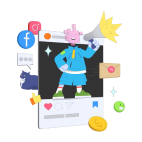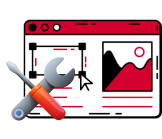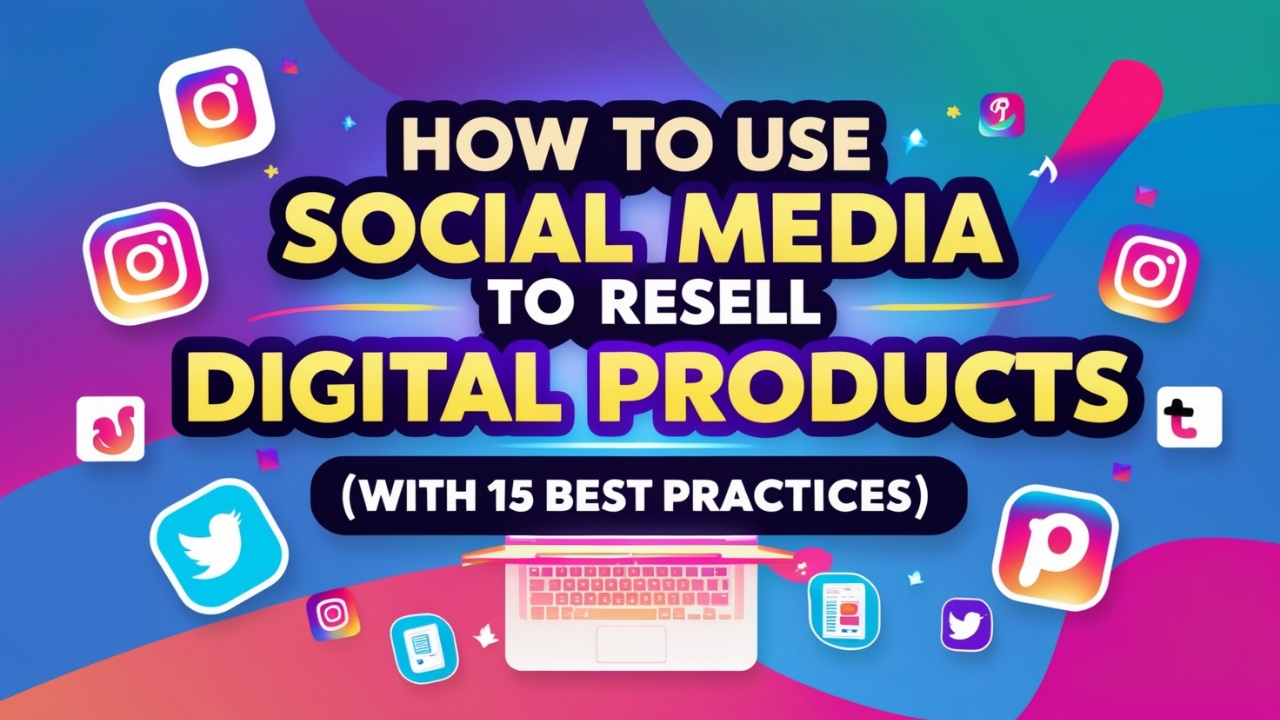If you’re like most people (in almost every possible country), you spend a lot of time scrolling through social media—it's almost like second nature, isn’t it?. But you could use that same time for a side-income opportunity. Yes, you could use all those hours people spend on Instagram, Facebook, or Pinterest to drive sales for your digital products. Sounds exciting, doesn’t it?
These days, social media is more than just sharing funny memes or keeping up with friends. It’s a powerful tool for selling digital products like eBooks, online courses, design templates, and software subscriptions. With millions of people online every day, it’s the perfect spot to showcase what you’ve got. This guide will show you how to make the most of social media to resell your digital products—everything from choosing the right platforms to creating content that pops, using ads, building a community, and more.
Choosing the Perfect Social Media Platforms for Your Digital Products
Needless to say, to successfully resell digital products, you’ve got to know where your potential customers hang out. If you’re selling visually appealing stuff like digital art or templates, platforms like Instagram and Pinterest are perfect—they’re all about the visuals and cater to folks looking for inspiration and creative ideas.
But if your digital product is more on the professional side—like a course or software—LinkedIn might be your go-to. It’s where business-minded people gather. And don’t sleep on TikTok! If your products appeal to a younger, trend-savvy crowd, TikTok could be a goldmine.
Focus on one or two platforms where your audience is most active. Take our advice, It’s better to be awesome on a few platforms than just okay on many.
Creating Engaging Content for Digital Product Promotion
Once you’ve picked the right platforms, it’s time for the next step. Start working on content. You need content that really grabs attention and effortlessly engaging. To consistently sell digital products, you need to create posts that are not only eye-catching but also valuable to your audience. Think beyond just showcasing your product. Share stories, offer tips, give tutorials, or show behind-the-scenes content that demonstrates how your product can make their lives better.
For example, if you’re selling an online course, create a series of short videos giving sneak peeks of the lessons. Or, if it’s a design template, show a time-lapse video of a project coming to life using your template. Your goal? Create content that educates, entertains, or inspires action.
Mix it up with videos, infographics, stories, and even memes to keep your audience interested and make your brand memorable.
Using Hashtags to Increase Visibility and Reach
Simply put, hashtags are like little signposts on social media (pointing people straight to your content and, eventually, your offer). They help categorize your posts and make them easily discoverable for folks searching for specific topics. When used correctly, hashtags can significantly boost your visibility and expand your reach to new audiences.
Dig a little to find the most popular and relevant hashtags in your niche. For example, if you’re selling digital planners, consider hashtags like #DigitalPlanner, #ProductivityTools, or #PlannerCommunity. But don't just stick to the popular ones—mix in some niche and branded hashtags to connect with a more targeted audience.
It’s important not to overdo it with hashtags. Keep things simple: 5-10 relevant hashtags for Instagram and up to 3 for Twitter. This will surely keep your content looking clean and focused, making it more effective.
Leveraging Instagram and Facebook Ads for Targeted Promotion
You may already know this. Organic reach is fantastic, but sometimes there are downtimes and you need a little extra help (especially when the algorithm gods aren’t in your favor). Instagram and Facebook ads let you target your promotions to specific demographics, interests, and even behaviors. This means you can reach exactly the type of people who are most likely to buy your products.
The best advice is to start small—test out different ad formats like carousel ads, video ads, or story ads. Use eye-catching visuals, clear and concise copy, and a strong call to action to encourage users to click through to your site or landing page.
Retargeting is another game-changer (and one you shouldn’t overlook). Use it to reach people who have already interacted with your content but haven’t purchased anything yet—these users are often more inclined to buy.
Building a Community Around Your Digital Products
Sure, making sales is great, but you know what’s even better? Building a community of loyal customers around your digital products. A dedicated community not only boosts sales but also turns your customers into brand advocates who promote your products for you (and who doesn’t love free marketing?).
The best way to do this? Create a space where your customers can connect with you and each other. This could be a Facebook Group, a Discord server, or even a dedicated hashtag on Instagram or Twitter (yes, hashtags can have a second job!). Use this space to engage with your customers, answer their questions, share tips, and offer exclusive content.
Keep the conversation flowing. Respond to comments, jump into conversations, and encourage your followers to share their experiences with your products. User-generated content is especially valuable—it’s real, it’s authentic, and it shows that your products actually work.
Building a community takes time, but the benefits—loyal customers who are excited about your brand—are totally worth the effort.
Collaborating with Influencers and Other Sellers
Influencer marketing isn’t just for big brands. Micro-influencers (those with smaller but more engaged followings) can be incredibly effective for promoting digital products. Put on detective hat and find influencers whose audiences align with your target market and suggest a partnership. This could involve a product review, a sponsored post, or even a joint giveaway.
But don’t stop just there. You could even consider partnering with other digital product sellers for bundle deals or cross-promotions. This can help you tap into each other’s audiences and offer more value to your customers.
When choosing influencers, focus on engagement rates, not just follower counts. An influencer with a smaller but highly engaged audience can drive more sales than one with a large but less engaged following. And when reaching out, be clear about what you’re offering—whether it’s a commission, a free product, or exposure to your audience.
Sharing Customer Testimonials and Success Stories
People trust people (especially when they’re saying nice things). Sharing customer testimonials and success stories on your social media can provide the social proof potential buyers need to take the plunge.
The best way to do this? Create appealing graphics with short quotes for Instagram or in-depth video testimonials for YouTube. Highlight specific benefits or results your customers have experienced to make the testimonials more compelling. Keep these testimonials in the spotlight by featuring them regularly on your profiles and stories, making it easy for potential customers to see how your product has made a real difference.
And remember (always a good idea): Ask permission before sharing a customer's story and make sure to give credit where it’s due (because nobody likes a credit thief).
Utilizing Instagram Stories and Facebook Live for Behind-the-Scenes Content
Want to show your audience the real you? (No, not the polished, perfect version—the actual, behind-the-scenes you.) Behind-the-scenes content is a fantastic way to reveal the personality behind your brand. It helps you connect on a deeper level and makes your digital products feel more relatable and down-to-earth.
Our advice? Use Instagram Stories for quick updates, sneak peeks, or even a glimpse into how your products are made (think of it as a digital ‘backstage pass’). And with Facebook Live, you can interact with your audience in real-time—whether it’s a Q&A session, a product demo, or just a casual chat. It's all about being genuine and letting your audience know there’s a real person behind the brand.
And here’s a little secret: This type of content doesn’t have to be perfect. A little bit of realness (like a blooper or a behind-the-scenes mishap) often makes it even more compelling. The main goal is to be authentic and let your audience see the person behind the brand.
Running Social Media Contests and Giveaways to Drive Engagement
Contests and giveaways are a great way to boost engagement, draw in new followers, and increase your digital product sales. The beauty of it? They’re easy to set up. Just ask your followers to like, share, or tag a friend in a post for a chance to win.
Our tip? Choose a prize that your audience can’t resist—like a free digital product, a bundle of courses, or a special offer with early access to new products. This not only gets people excited but also gives winners a taste of what you offer, turning them into loyal customers.
Keep the entry requirements simple and the rules crystal clear (because no one wants to read a rulebook longer than a novel). The easier it is to enter, the more people will join in.
Monitoring and Measuring Social Media Performance for Digital Product Sales
Okay, so you’ve been posting away, but how do you know if it's actually working? (Hint: it’s not just about the likes and shares.) To make sure your social media efforts are driving digital product sales, it’s important to keep an eye on your performance regularly. This means tracking key metrics like engagement, click-through rates, conversion rates, and—you guessed it—overall sales.
Get familiar with tools like Google Analytics, Facebook Insights, and Instagram Analytics to collect and analyze your data. See which content resonates most, which platforms are sending the most traffic your way, and which strategies are turning interest into sales.
Set specific, measurable goals for your social media campaigns—like increasing website traffic by 20% over three months or boosting conversion rates by 10%. Check your progress regularly and tweak your strategy as needed to stay on course.
Utilizing Pinterest and YouTube for Visual and Video Content
Pinterest and YouTube are fantastic platforms for promoting digital products, especially those that benefit from visual or video content. Pinterest’s focus on visually engaging content makes it ideal for showcasing digital products like planners, templates, or eBooks. Use eye-catching images and compelling descriptions with strong calls to action to drive traffic from your pins to your product pages.
And then there’s YouTube—a great space for more detailed video content. Tutorials, how-to guides, and product demos can show off the practical benefits of your digital products. Plus, optimizing your videos for search engines (a little SEO magic) can help you reach an even bigger audience.
Don’t forget about Pinterest’s Rich Pins and YouTube’s Cards and End Screens. These may look not huge, but it can boost user engagement and increase click-through rates.
Creating Exclusive Offers and Promotions for Social Media Followers
Everyone loves to feel special (even if it’s just for a discount). Creating a sense of exclusivity can work wonders for your sales. Offering special promotions or discounts just for your social media followers doesn’t just drive sales; it also builds a loyal community (and who doesn’t want a digital fan club?). Now, this could be limited-time discounts, buy-one-get-one-free deals, or even early access to new products, all just for your social media audience.
And, announce these deals through posts, stories, or even live sessions to crank up the excitement (and urgency!). Make it clear these offers are just for them—nothing like a bit of "special treatment" to make followers feel valued and more likely to jump on board.
If you have over 10,000 followers on Instagram, use the "Swipe Up" feature in Stories to link directly to your product page, making it easy for followers to take advantage of your offers.
Building an Email List through Social Media Channels
Social media is fantastic for reaching new potential customers, but your email list? That’s where your direct communication happens Use your social media channels to grow this list by offering something valuable (like a free eBook, a super-useful checklist, or even a sweet discount) in exchange for an email sign-up.
First you need to promote your freebie through posts, ads, or Stories, and direct traffic to a landing page where users can sign up.. Once they're on your list, you can nurture these leads with targeted email campaigns that encourage repeat purchases and build long-term customer relationships.
Just make sure your lead magnets are closely related to your digital products. This way, your new email subscribers are genuinely interested in what you offer, making them way more likely to become paying customers (and we all want that, don’t we?).
Using Social Media to Provide Customer Support and Feedback
The social media world is always changing (blink, and you might miss the next big thing!). New trends, features, and algorithm changes are happening all the time. Staying up-to-date with these changes is key to keeping your social media strategy on point. Our advice? Follow industry blogs, subscribe to newsletters, and stay active in relevant online communities to keep yourself informed.
And don't just stop at solving problems—ask for feedback on your digital products. This not only makes your customers feel heard (and who doesn’t like being heard?) but also gives you valuable insights to improve what you're offering. Share any updates or changes you make based on customer feedback to show you’re listening and always aiming to provide the best.
Consider setting up a dedicated support handle on Twitter or using Facebook Messenger bots to automate responses to common questions. (Because, let’s face it, you can’t be everywhere at once, and a little help from bots can go a long way.)
Staying Up-to-Date with the Latest Social Media Trends and Algorithm Changes
Social media is like a fast-moving train—new trends, features, and algorithm changes happen all the time. Staying up-to-date is essential if you want to keep your social media strategy on point. Our best advice? Follow industry blogs, subscribe to newsletters, and stay active in relevant online communities to stay in the know.
Being quick to adopt new features or trends—like Instagram Reels or Facebook Shops—can give you a competitive edge and help you tap into new audiences (plus, it’s fun to try new things, right?). Always be ready to tweak your strategy to stay relevant and effective.
Experiment with new features as they become available. For instance, Instagram Reels can be a fantastic way to engage a younger audience with short, snappy content. Similarly, Facebook Shops let you sell directly from your Facebook page, simplifying the buying process.
Conclusion
Selling digital products on social media is more than just posting pretty pictures—it’s about understanding your audience, creating engaging content, and using the right tools and strategies to reach and convert potential customers. By implementing the tips in this guide, you'll be well on your way to mastering social media as a powerful sales channel.
Remember, consistency, authenticity, and engagement are key. Take these strategies, apply them to your own social media marketing plan, and watch your digital product sales grow. Have tips or tricks that have worked for you? Share them in the comments below!
And if you’re looking to further enhance your digital efforts, consider exploring InternetKeeda.
With over 100,000 top-tier products, flexible plans, and options to become a reseller or build your own marketplace, InternetKeeda provides all the tools you need to succeed in the digital world. Start your journey today and turn the growing demand for digital products into a profitable venture.
 Bundles
Bundles Flash Sales
Flash Sales






















Comments (0)